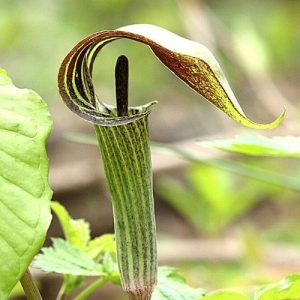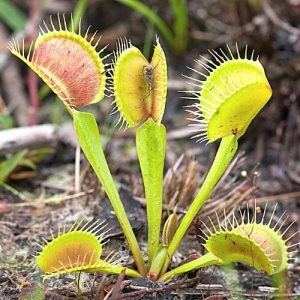Unusual Bulb Species Worth Growing in the Woodland Garden
One of my favorite gardens is the woodland garden. Add a small pond and you instantly create the perfect setting for many types of plants, including bulbs. Although most bulbs do not prefer shady or bog-like conditions, some unusual varieties will actually thrive in these environments, mimicking their natural habitats.
 Resembling the daffodil with exception to its long, spidery-looking fingers, the Peruvian daffodil (Hymenocallis narcissiflora) makes an exceptional choice for the woodland garden, especially in boggy-like conditions. Not only will the white blooms brighten up the garden, but this South American native is extremely fragrant too. If you have a moist, partially shaded spot in the garden, the Stinking iris (Iris foetidissima) will be quite at home. With its unusual color (pale yellow-lilac) and unpleasant smell, the stinking iris is a strange, yet appealing plant. This summer-blooming bulb develops into a pod of brilliant scarlet-colored berries in autumn. Neomarica is commonly called the Walking iris, as it appears to “walk” through the garden with graceful foliage and flowers. This unusual bulb tolerates a wide range of soil and light conditions and makes an excellent accent along wooded paths and pond edges.
Resembling the daffodil with exception to its long, spidery-looking fingers, the Peruvian daffodil (Hymenocallis narcissiflora) makes an exceptional choice for the woodland garden, especially in boggy-like conditions. Not only will the white blooms brighten up the garden, but this South American native is extremely fragrant too. If you have a moist, partially shaded spot in the garden, the Stinking iris (Iris foetidissima) will be quite at home. With its unusual color (pale yellow-lilac) and unpleasant smell, the stinking iris is a strange, yet appealing plant. This summer-blooming bulb develops into a pod of brilliant scarlet-colored berries in autumn. Neomarica is commonly called the Walking iris, as it appears to “walk” through the garden with graceful foliage and flowers. This unusual bulb tolerates a wide range of soil and light conditions and makes an excellent accent along wooded paths and pond edges.
Check Out: Caring For Your Plant Bulbs
 The jack-in-the-pulpit (A. triphyllum) is a species of the Arum genus and native to North America. This unusual looking plant may be purplish-striped, greenish-white striped, or brown and white striped, depending on the particular variety. These bulbs look great in masses along streams and ponds or as edging in woodland gardens. As with many Arum species, the jack-in-the-pulpit reaches its peak in autumn, adding seasonal interest to the woodland garden with beautiful crimson berries. Its cousin, the Skunk Cabbage (S. foetidus), also makes an interesting addition along the borders of ponds or streams within woodland areas. The Dragon flower (Dracunculus vulgaris) is another notable Arum member. This unusual plant, also called Voodoo lily, resembles a dragon’s tongue, and emits a foul odor similar to rotten meat. This bulb prefers moist, humus-rich soil, making a wonderful accent to woodland gardens or pond edges. Good companions include caladium, elephant ears, jack-in-the-pulpits, hosta, and coleus.
The jack-in-the-pulpit (A. triphyllum) is a species of the Arum genus and native to North America. This unusual looking plant may be purplish-striped, greenish-white striped, or brown and white striped, depending on the particular variety. These bulbs look great in masses along streams and ponds or as edging in woodland gardens. As with many Arum species, the jack-in-the-pulpit reaches its peak in autumn, adding seasonal interest to the woodland garden with beautiful crimson berries. Its cousin, the Skunk Cabbage (S. foetidus), also makes an interesting addition along the borders of ponds or streams within woodland areas. The Dragon flower (Dracunculus vulgaris) is another notable Arum member. This unusual plant, also called Voodoo lily, resembles a dragon’s tongue, and emits a foul odor similar to rotten meat. This bulb prefers moist, humus-rich soil, making a wonderful accent to woodland gardens or pond edges. Good companions include caladium, elephant ears, jack-in-the-pulpits, hosta, and coleus.
Check Out: Flower Bulbs for Beginners
 The carnivorous Venus flytrap (Dionaea muscipula) lives within boggy areas of North and South Carolina along the eastern U.S. Although it is commonly grown indoors as a houseplant, the Venus flytrap can just as easily be grown outside in humid, wooded areas that mimic its natural environment, such as a bog garden. Flytraps benefit from being near tall plants that can provide some shade. An unusual Asian species native to Japan, the white Egret flower (Habenaria radiata) resembles an egret bird in flight. This bulb should be treated as a bog plant and makes an attractive companion to other bog plants, including carnivorous species such as pitcher plants and Venus flytraps. Also native to Asia, and members of the genus Tricyrtis,Toad lilies send up interesting orchid-like blooms that are usually spotted in different shades of purple. Blooming takes place in the fall, when most plants have lost their appeal. These unusual bulbs look great placed in areas with lots of shade and plenty of moisture, making them exceptional candidates for the woodland bog garden.
The carnivorous Venus flytrap (Dionaea muscipula) lives within boggy areas of North and South Carolina along the eastern U.S. Although it is commonly grown indoors as a houseplant, the Venus flytrap can just as easily be grown outside in humid, wooded areas that mimic its natural environment, such as a bog garden. Flytraps benefit from being near tall plants that can provide some shade. An unusual Asian species native to Japan, the white Egret flower (Habenaria radiata) resembles an egret bird in flight. This bulb should be treated as a bog plant and makes an attractive companion to other bog plants, including carnivorous species such as pitcher plants and Venus flytraps. Also native to Asia, and members of the genus Tricyrtis,Toad lilies send up interesting orchid-like blooms that are usually spotted in different shades of purple. Blooming takes place in the fall, when most plants have lost their appeal. These unusual bulbs look great placed in areas with lots of shade and plenty of moisture, making them exceptional candidates for the woodland bog garden.
Check Out: Complete Guide to Soil
 Trilliums are native to cool, wooded areas, blooming in early spring with colors ranging from pink and maroon to yellow and white. White trillium (t. grandiflorum) is the most common of the species with nodding white blooms that eventually age into bright pink. This little bulb is ideal for shaded woodland gardens, growing alongside crested iris, jack-in-the-pulpit, hostas, toad lilies, and ferns. Since many of these are now considered endangered, they shouldn’t be collected from the wild. Instead, seek out a reputable grower. Lady’s slipperis a species of the genus Cypripedium and member of the orchid family. The flower resembles a slipper, and the dainty blooms range from white, yellow, and deep pink to nearly purple, remaining closed with exception to the small opening in the front. Lady’s slipper prefers to grow in its natural environment within shady woodland areas. However, as with trilliums, collecting from the wild is strongly discouraged.
Trilliums are native to cool, wooded areas, blooming in early spring with colors ranging from pink and maroon to yellow and white. White trillium (t. grandiflorum) is the most common of the species with nodding white blooms that eventually age into bright pink. This little bulb is ideal for shaded woodland gardens, growing alongside crested iris, jack-in-the-pulpit, hostas, toad lilies, and ferns. Since many of these are now considered endangered, they shouldn’t be collected from the wild. Instead, seek out a reputable grower. Lady’s slipperis a species of the genus Cypripedium and member of the orchid family. The flower resembles a slipper, and the dainty blooms range from white, yellow, and deep pink to nearly purple, remaining closed with exception to the small opening in the front. Lady’s slipper prefers to grow in its natural environment within shady woodland areas. However, as with trilliums, collecting from the wild is strongly discouraged.



Comments are closed, but trackbacks and pingbacks are open.